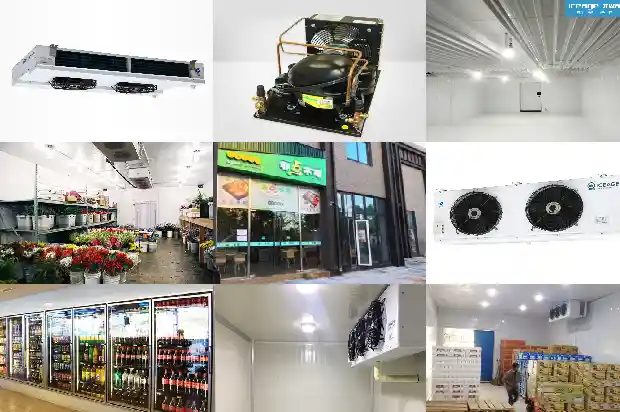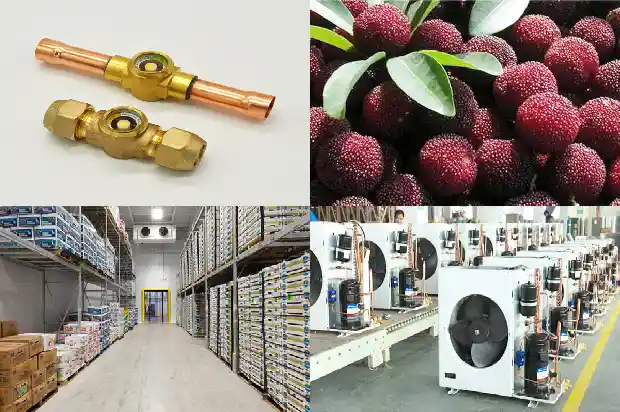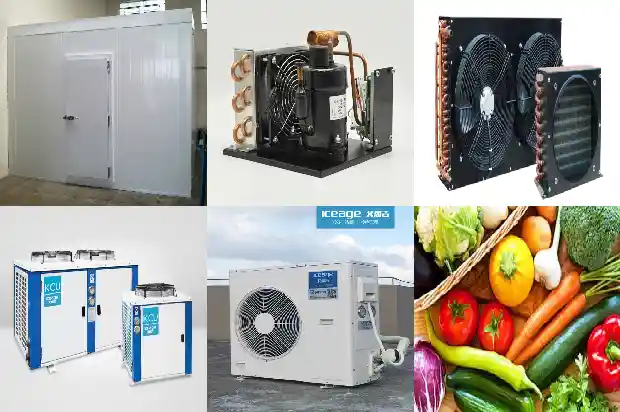Maintenance and Operation of Freezing and Cold Storage Warehouses
2024-11-21
I. Operation and Maintenance Management of Cold Storage
Preparation before Startup
Before starting up, first check whether all valves of the unit are in the normal startup state, and check whether the cooling water source is sufficient. After turning on the power supply, set the temperature according to requirements. The refrigeration system of the cold storage is generally automatically controlled. However, when it is used for the first time, the cooling water pump should be started first, and then the compressors should be started one by one after it operates normally.
Operation Management
After the refrigeration system operates normally, the following points should be noted:
- Listen to whether there are abnormal sounds during the operation of the equipment.
- Check whether the temperature inside the cold storage drops.
- Touch to check whether the heat and cold of the suction and exhaust are distinct and whether the cooling effect of the condenser is normal.

Ventilation and Defrosting
During the storage process, fruits and vegetables will release some gases. When accumulated to a certain extent, it will cause physiological disorders of the stored items and lead to deterioration and change of taste. Therefore, ventilation should be carried out frequently during the use process, and it is generally advisable to choose to do it in the morning when the temperature is relatively low. In addition, after the cold storage has been used for a period of time, a layer of frost will form on the evaporator. If it is not removed in time, it will affect the refrigeration effect. When defrosting, cover the stored items in the cold storage, use a broom to sweep the accumulated frost, and be careful not to knock it hard.
- For the evaporator of the air-cooled unit: Frequently check the defrosting situation. Whether the defrosting is timely and effective will affect the refrigeration effect and lead to the return of liquid in the refrigeration system.

- Frequently observe the operating state of the compressor and check its exhaust temperature. During the operation in different seasons, pay special attention to the operating state of the system and adjust the liquid supply amount and condensation temperature of the system in a timely manner.
- For the operating unit: Frequently observe the oil level, oil return situation and cleanliness of the oil of the compressor. If the oil is dirty or the oil level drops, solve the problem in a timely manner to avoid poor lubrication.
- Listen carefully to the operating sounds of the compressor, cooling tower, water pump or condenser fan. Deal with any abnormalities in a timely manner. At the same time, check the vibration conditions of the compressor, exhaust pipe and foundation bolts.
- For the maintenance of the compressor: In the initial stage, the internal cleanliness of the system is relatively poor. Replace the refrigeration oil and the drying filter once after 30 days of operation, and then replace them again after half a year of operation (it depends on the actual situation). For systems with higher cleanliness, the refrigeration oil and the drying filter should also be replaced once after half a year of operation, and then it depends on the situation later.
- For the operating unit: Frequently observe the oil level, oil return situation and cleanliness of the oil of the compressor. If the oil is dirty or the oil level drops, solve the problem in a timely manner to avoid poor lubrication.
- For the air-cooled unit: Frequently clean the air cooler to keep it in a good heat exchange state. For the water-cooled unit: Frequently check the turbidity of the cooling water. If the cooling water is too dirty, replace it. Check whether there are problems such as foaming, bubbling, dripping and leakage in the water supply system. Check whether the water pump operates normally, whether the valve switch is effective and whether the cooling tower fan operates normally.
- For the evaporator of the air-cooled unit: Frequently check the defrosting situation. Whether the defrosting is timely and effective will affect the refrigeration effect and lead to the return of liquid in the refrigeration system.
- Frequently observe the operating state of the compressor: Check its exhaust temperature. During the operation in different seasons, pay special attention to the operating state of the system and adjust the liquid supply amount and condensation temperature of the system in a timely manner.
- Listen carefully to the operating sounds of the compressor, cooling tower, water pump or condenser fan. Deal with any abnormalities in a timely manner. At the same time, check the vibration conditions of the compressor, exhaust pipe and foundation bolts.
- For the maintenance of the compressor: In the initial stage, the internal cleanliness of the system is relatively poor. Replace the refrigeration oil and the drying filter once after 30 days of operation, and then replace them again after half a year of operation (it depends on the actual situation). For systems with higher cleanliness, the refrigeration oil and the drying filter should also be replaced once after half a year of operation, and then it depends on the situation later.
II. Operation Manual for Cold Storage Maintenance
Temperature inside the Cold Storage
- Check whether the temperature-sensing elements in the cold storage are in the correct positions or damaged.
- Check whether there are any cold leakage points on the body of the cold storage and whether the cold storage door is closed tightly.
- Check whether the temperature of the goods entering the cold storage is too high.
- Check whether the fan operates normally.
- Check whether the frost layer on the fan coil is too thick. If it is too thick, appropriately increase the defrosting time.
- Reduce the number of times the door is opened.
- Check whether there are a large number of water marks in the cold storage and whether the humidity is too high.
- Check whether the refrigeration system operates normally.
Fan State
- Check whether there are abnormal sounds during the operation of the fan and whether the suspension rod brackets of the fan are loose or abnormal.
- Check whether the fan blades rotate, are deformed or rub against the casing. Correct or replace them in a timely manner.
- Check whether there are any sundries wrapped around the fins of the fan and clean them in a timely manner.
- Check whether the fan casing and chassis are rusted. If they are rusted, polish them with sandpaper and repaint them with anti-rust paint.
Defrosting System
- When the fan coil is defrosting, the fan is strictly prohibited from operating. It can only be started after it is confirmed that the defrosting is completely finished.
- When it is not suitable for goods to enter or leave during defrosting to avoid a larger temperature difference.
- Check the defrosting situation of the fan coil to see whether the frost layer is completely removed, and record the defrosting time so as to adjust the defrosting time according to the defrosting effect to achieve the best effect. HVACRBK (Refrigeration Encyclopedia).
- Check whether the voltage and current of the defrosting electric heating tube are within the normal range. If they are abnormal, check, repair or replace them in a timely manner.
Drainage System
- Keep the water receiving tray clean and free of sundries, and ensure that there are no obstacles at the water outlet of the water receiving tray.
- Check whether the drainage pipe and its insulation layer are damaged. If so, repair them in a timely manner.
- Check whether the drainage is smooth. If it is slower than before, dredge it after shutting down the equipment to prevent dirty blockage or ice blockage of the drainage.
- Check whether the heating wire in the drainage pipe works normally to prevent water accumulation and ice blockage.
Body and Door of the Cold Storage
- Check whether the cold storage panels are damaged by collision. If the insulation layer is damaged, it should be re-foamed and the external vapor barrier protection should be done well. If the external steel plate is damaged, it should be repaired in a timely manner and anti-corrosion treatment should be carried out.
- The cold storage door should be frequently checked to see whether it opens flexibly, whether the door body is tilted, whether the nuts are loose and whether the sealing rubber strips on the door edge are aged. If there are such problems, repair or replace them in a timely manner.
Electric Control System
Check whether there are phenomena of insulation damage such as being bitten by rats, peeling, overheating and aging for the control elements and wiring in the electric control box, and check whether the joints are loose.
Temperature Inspection
- Check and record whether the temperature displayed on the current temperature display instrument is within the normal range.
- Check whether there are abnormal temperature records in the "Temperature Record Table".
- Use your own digital thermometer to actually measure the temperature inside the cold storage to detect whether the original temperature display instrument of the cold storage is normal. Otherwise, repair or replace it.
Evaporator of the Air Cooler
- Check whether the voltage and current of the fan during operation are within the normal range.
- Remove the oil stains at the fan bearings and add new lubricating oil.
- Check whether there are any residual water droplets around the blades to prevent the blades from being stuck by ice formed from the water droplets.
- Check whether the center of the blade shaft is deviated. If the gasket is uneven or the bolts are loose, it is easy to cause deviation.

- Check whether the electrical wiring of the fan is damaged, whether the joints are loose and the insulation degree of the motor.
- Check the wind speed and air volume. If the wind speed is not high or the air volume is uneven, check whether the stacking of goods is reasonable and whether there are dust or foreign objects blocking the air outlet.
- The surface of the coil and fins of the air cooler should be evenly frosted. If the frosting is uneven or there is no frost, the liquid supply is abnormal. Analyze and find the reasons from the whole system.
Defrosting
- Check the defrosting effect of the air cooler and whether there are ice lumps. Carefully remove the ice lumps and appropriately adjust the defrosting time.
- Check the voltage, current and insulation degree of the electric heating tube.
Heating Wire in the Drainage Pipe
- Check whether the drainage is smooth and whether there is ice blockage, and dredge it in a timely manner.
- Detection of the drainage electric heating wire.
Electric Control System
- Check whether there are phenomena of insulation damage such as being bitten by rats, peeling, overheating and aging for the control elements and wiring in the electric control box, and check whether the joints are loose.
Related Articles
- Basic Faults and Preventive Maintenance of Water - cooled Units
- Essential for Maintenance! Parameters and Phenomena of Normal Operation of Refrigeration and Heating Systems
- Welding Equipment Used in Refrigeration System Maintenance
- Maintenance Methods for Small Modular Cold Storage Failures
- Maintenance Techniques for Air - conditioning Refrigeration Systems
- Maintenance Strategies for the Working Cycle and Electrical Automatic Control of Chillers
- Essential Basics for Maintenance, Debugging of Refrigeration and Air - conditioning Systems
- 8 Maintenance Procedures for Industrial Chillers
- Requirements and Maintenance for Building Meat Food Cold Storage
- Maintenance Methods for Faults in Screw Refrigeration Air - conditioner Compressors
- Maintenance Methods for Refrigerant Leak in Air - conditioner Outdoor Unit
- Knowledge, Installation and Maintenance of Cold Storage Systems
- Are you familiar with the detection and maintenance methods of air conditioner components?
- Water-cooled Screw Chiller: Operation and Maintenance
- Daily Maintenance Training for Users after Installation of Small and Medium-Sized Cold Storages
- Maintenance of Screw Chiller
- Maintenance of Screw Chiller
- On the maintenance and inspection of external insulation layers of pipes in refrigeration devices
